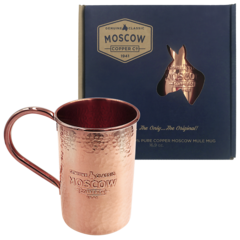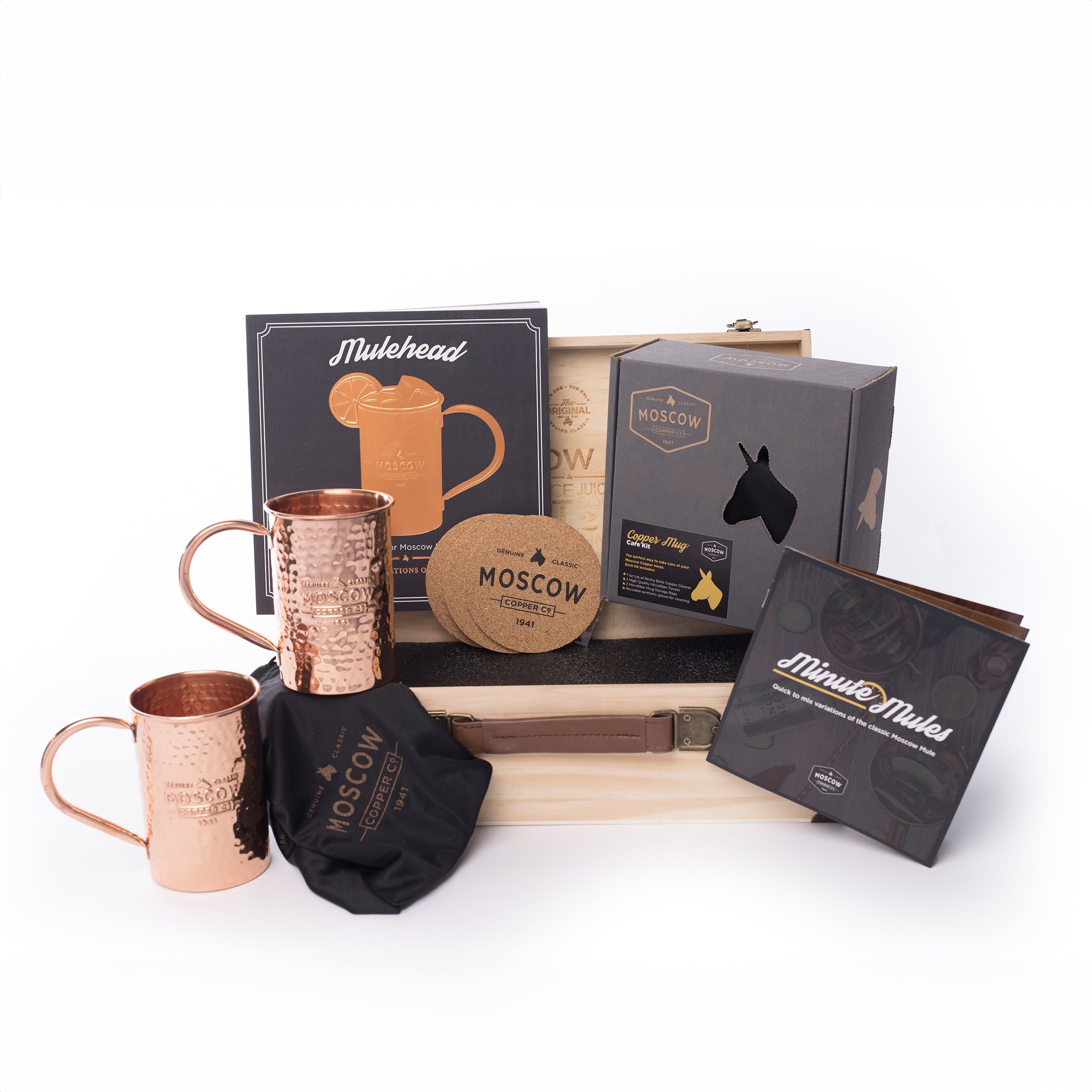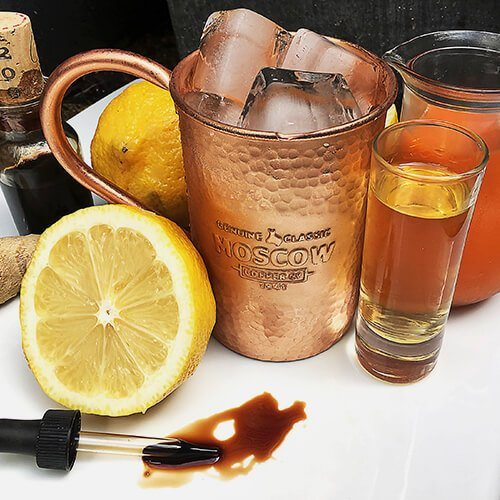The History and Utility of Drinking from Copper Cups
The human body requires an array of micronutrients to survive. Among them: copper. Meaning, copper cups aren’t just essential for Moscow Mules, the metal is also essential for survival.
The Office of Dietary Supplements advises that adults adhere to a dietary intake of 900 mcg. Doing so is said to support a variety of health benefits from fighting cancer-causing free radicals to anti-aging and weight loss.
But the benefits of drinking from copper certainly aren’t new. Copper has been used for decorative, utilitarian and health purposes dating back 10,000 years. In fact, it was one of the first metals discovered by man and was used exclusively for more than five millennia!
According to History.com, “Humans may have started smelting copper as early as 6,000 B.C. in the Fertile Crescent, a region often called ‘the cradle of civilization’ and a historical area of the Middle East where agriculture and the world’s first cities emerged.”
Today, we’re stepping back in time for a tour of copper’s international evolution.
The Bronze Age
Starting about 3300 BC, if you used any kind of tool, weapon, or armor it was almost certainly made with bronze. For centuries, it was the most prolific metal around and so popular that it defined a stretch of 2,000 years known as ‘The Bronze Age’.
During this time humans made major technological achievements like the wheel and writing that still help our societies run to this day.
Copper, originally from its namesake Cyprus, was popular in the Middle East, while the true origins of bronze remain unknown. Though different civilizations entered into the Bronze Age at different times, China and Greece 3000 BC and Britain in 1900 BC, its reign ended abruptly and all at once around 1200 BC. The cause is likely due to a collapse of the ancient world and the creation of international trade routes.
Out of necessity, copper and its alloys kept the world going when trade interruptions threatened to undo centuries of progress. Many of the staples that evolved are still in use today.
Tamra Jal + Ayurvedic Era
The history of copper continues in India. There, storing water in copper vessels and cups is a process known as Tamara Jal, which began thousands of years ago.
The region is the known birthplace of a practice of natural remedies collectively known as Ayurveda, which translates to “knowledge of life”. To help balance the three doshas (Kapha, Vata, and Pitta) or elements associated with Ayurveda, water is kept in a large copper vessel or pitcher overnight and ingested first thing in the morning. The act helps maintain a balanced pH level in the body by utilizing the electro-magnetic energy of the metal to ionize the water.
Additionally, The Hindu explains, “a 2012 study published in Journal of Health, Population, and Nutrition, storing contaminated water in copper for up to 16 hours at room temperature considerably reduces the presence of the harmful microbes, so much that the researchers inferred that ‘copper holds promise as a point-of-use solution for microbial purification of drinking-water.’”
Copper Health Benefits
Copper is more than just a metal; it's a powerful element with a wide range of health benefits that have been recognized for centuries. Whether ingested through food, water, or even absorbed through the skin, copper plays a crucial role in maintaining overall health.
Antimicrobial Properties
One of copper's most celebrated health benefits is its ability to kill harmful microbes. Copper surfaces have been shown to eliminate bacteria, viruses, and fungi on contact. This is particularly valuable in healthcare settings, where copper-infused surfaces can help reduce the spread of infections. But even outside of hospitals, drinking from copper vessels can help purify water by reducing the presence of harmful pathogens, making it safer for consumption.
Antioxidant Powerhouse
Copper is a potent antioxidant, meaning it helps neutralize free radicals that can cause cellular damage. Free radicals are unstable molecules that can lead to oxidative stress, a process linked to aging, cancer, and various chronic diseases. By incorporating copper into your daily routine—whether through diet or by using copper vessels—you can help protect your body from these harmful effects.
Supports Immune Function
Copper is essential for the proper functioning of the immune system. It plays a role in the production and function of white blood cells, which are the body's first line of defense against infections. A healthy immune system is crucial for warding off illnesses and recovering quickly when you do get sick.
Enhances Brain Health
Copper is also vital for brain health. It contributes to the synthesis of neurotransmitters—chemical messengers that help nerve cells communicate. Adequate copper levels support cognitive function, memory, and overall brain health. A deficiency in copper has been linked to neurological issues, including Alzheimer's disease.
Promotes Healthy Skin
Copper is often used in skincare products because of its ability to stimulate the production of collagen and elastin, two proteins that are essential for maintaining youthful, firm skin. Copper's antioxidant properties also protect the skin from damage caused by free radicals and environmental stressors, potentially slowing the aging process.
Aids in Iron Absorption
Copper plays a key role in the body’s ability to absorb and utilize iron, a mineral essential for the formation of red blood cells. Proper iron absorption prevents anemia, a condition characterized by fatigue and weakness. By maintaining adequate copper levels, you ensure that your body can effectively produce hemoglobin and transport oxygen throughout your body.
Supports Cardiovascular Health
Copper is crucial for maintaining the health of your cardiovascular system. It helps regulate blood pressure, supports the formation of new blood vessels, and ensures that your heart muscles function properly. Some studies suggest that copper deficiency may contribute to cardiovascular diseases, making it important to ensure you're getting enough of this essential nutrient.
Bone Health
Copper plays a role in maintaining healthy bones by aiding in the formation of collagen, which is a component of bone and connective tissue. Adequate copper levels contribute to bone density and strength, helping to prevent conditions like osteoporosis, particularly as we age.
Modern Scientific Research on Copper’s Health Benefits
Recent Studies on Copper and Human Health
Recent research has confirmed copper’s powerful health benefits, particularly its antimicrobial, antioxidant, and anti-inflammatory properties. Studies show that copper ions disrupt the membranes of bacteria, fungi, and viruses, leading to their destruction. This bactericidal effect, driven by the generation of reactive oxygen species (ROS), makes copper a potent antimicrobial agent. Additionally, copper’s antioxidant properties help neutralize free radicals, reducing oxidative stress linked to chronic diseases such as cancer and cardiovascular conditions (RSC Publishing).
Copper in Healthcare Settings
In healthcare, copper’s antimicrobial properties are being harnessed to reduce infections in hospitals. Copper-infused surfaces, textiles, and medical devices are now being used to minimize the spread of healthcare-associated infections (HAIs). Studies indicate that surfaces made from copper alloys can kill over 99% of harmful bacteria within two hours, significantly lowering the risk of contamination in critical environments such as intensive care units (RSC Publishing).
Incorporating Copper into Your Routine
Given these diverse health benefits, it’s easy to see why copper has been revered for thousands of years. Whether you're using a copper vessel for your morning water or ensuring your diet includes copper-rich foods like nuts, seeds, and leafy greens, incorporating copper into your routine can have lasting positive effects on your health.
The Future of Copper in Wellness
Innovations in Copper-Infused Products
Copper's health benefits are increasingly being harnessed in innovative wellness products, particularly in fabrics and bedding. For example, copper-infused bedsheets and quilts are now designed to combat bacteria, fungi, and viruses, offering antimicrobial protection round the clock. These fabrics help reduce odors, improve skin circulation, and promote a cleaner, healthier sleep environment. In addition to their health benefits, copper-infused products like memory foam mattresses are gaining popularity for their cooling effects, which help regulate body temperature and enhance sleep quality (Copper Clothing, Spring Air, Spring Textile).
Copper is also being integrated into clothing and accessories. Copper-infused fabrics are used in everything from socks and gloves to sportswear and even compression gear. These products leverage copper's natural properties to reduce inflammation, improve circulation, and provide antibacterial protection, making them ideal for both everyday use and athletic recovery (Spring Textile).
Copper and Sustainability
Copper is not only beneficial for health but also for sustainability. Its durability means that copper-infused products tend to have a longer lifespan, reducing the need for frequent replacements. Additionally, copper is highly recyclable, making it an eco-friendly choice for consumers who are conscious of their environmental impact. Products like copper-infused bedding and fabrics are often manufactured with sustainability in mind, using processes that minimize waste and avoid harmful chemicals (Spring Textile).
Incorporating copper into your lifestyle, whether through bedding, clothing, or other products, offers a combination of health benefits and environmental advantages, aligning with the growing demand for sustainable wellness solutions.
Conclusion
Throughout history, our ancestors recognized the value of copper for both its health benefits and utility. From purifying water through the practice of Tamra Jal in India to the widespread use of copper in the Bronze Age, copper has long been integral to human health and progress. Even today, many believe in the healing properties of copper, whether drinking from a copper vessel or wearing copper jewelry for potential arthritis relief.
If you’re looking to incorporate this ancient practice into your modern life, consider using a 96 oz copper mug to purify your morning water and help balance your body. Need help making your selection or just want to talk about the wonders of copper? We’re here to help.
The contents of this website are for educational purposes and are not intended to offer personal medical advice. Before deciding to drink out of copper, talk to your doctor or another medical professional.







